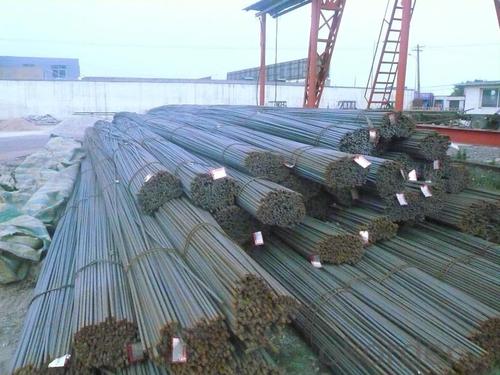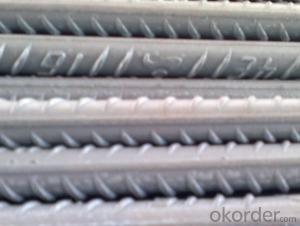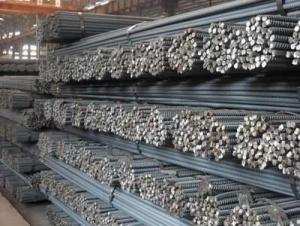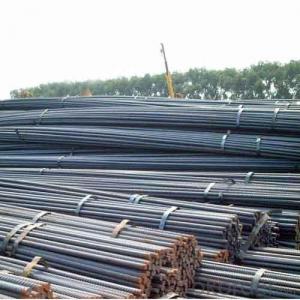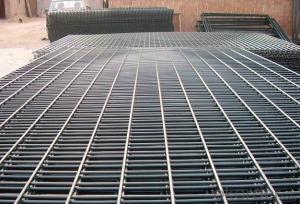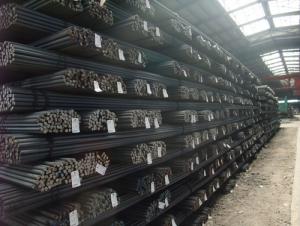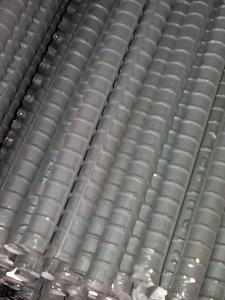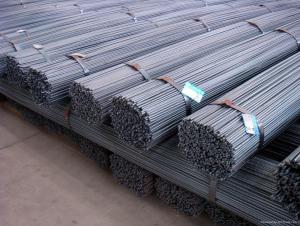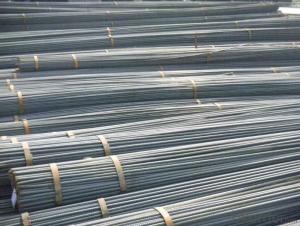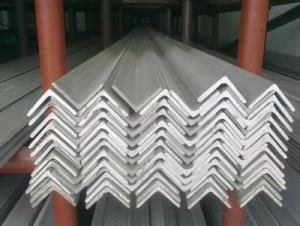Hot-Rolled Steel Deformed Bar,Rebar,Deformed Steel Bar
- Loading Port:
- Shanghai
- Payment Terms:
- TT OR LC
- Min Order Qty:
- 100 m.t.
- Supply Capability:
- 1000 m.t./month
OKorder Service Pledge
OKorder Financial Service
You Might Also Like
deformed steel bar grade 40
material: HRB400, BS4449 GR460B
size: 8-36mmx12m.
short delivery time by bulk or container
deformed steel bar grade 40
material: HRB400, BS4449 GR460B
size: 8-36mmx12m.
short delivery time with bulk or container
packing: Mill standard export packing in bundles/coil, around 2tons/bundle.
country of Origin: China
delivery Time: Within a 35 days
Shipment: by bulk vessel or by container
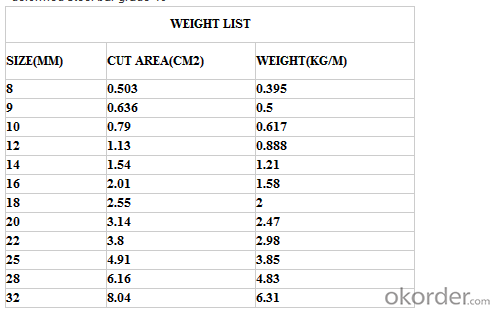
Leading goods:
section steel:angles,channels,I-beam,H-beam;
coils:cold/hot rolled coils,PPGI,galvanized coils,plate,checkered plate,cutting steel plate,steel strip;
wire rod:steel wire,deformed wire,bar;
pipe:seamless pipe,rectangular pipe,welded pipe,spiral welded pipe,pipe fittings;
stainless steel:steel sheets,stainless steel strips,stainless bar,stainless tube;
special:weathering steel,shipbuilding steel;
construction steel:C-channel,Z-channel,T-bar,high-speed divider plate,corrugated steel plate,steel grating.
Advantage:
We are the spot supplier, Six huge warehouses which can hold 20,000 MT goods.
It makes the cost lower than others,we can provide the competitive price for you.
Delivery time:
Normal sizes can be provided in 7days, the others should be ready in 30---45 days.
Further treatment:
We can offer cutting,painting,drilling holes,bending,threading, welding,galvanization,packing etc.
Security interest:
We have already passed the ISO9001, BV and SGS authentication which makes the quality secured.
If you have the interest in any of the products we can provided, pls don't hesitate to connect with me. Looking forward to cooperate with you.

FAQ of Steel Deformed Bar
1. More than 10 years experience in this industry
2. 100,000 tons exporting per month
3. Professional foreign trade tea
4. OEM&ODM capacity
5. High quality assured & competitive price
6. Try our best to meet your needs & save your budget
7. Very popular in Southeast Asia, Africa, Mid-East and South America etc.
8. VIP membership system, first time customers and long-term cooperation customers can get extra discount on some products.
- Q: What is the role of steel rebars in increasing the load-carrying capacity of a structure?
- Steel rebars play a crucial role in increasing the load-carrying capacity of a structure. They are used as reinforcement in concrete structures to enhance their strength and durability. Rebars are typically made of carbon steel and are designed to withstand tension forces in the structure. When concrete is subjected to heavy loads or external forces, it tends to crack or deform. Steel rebars are placed strategically within the concrete to counteract these forces and prevent the formation of cracks. By distributing the load across a wider area, rebars help in improving the structural integrity of the entire system. The interlocking nature of rebars with the surrounding concrete also allows for the transfer of stresses between the two materials. This ensures that the load is evenly distributed throughout the structure, reducing the chances of localized failures or collapses. Moreover, steel rebars provide additional tensile strength to the concrete, which is otherwise weak in tension. Concrete is strong in compression but relatively weak in tension, and the introduction of rebars helps to counterbalance this weakness. The rebars act as a reinforcement framework, absorbing the tensile forces and preventing the concrete from cracking or failing under excessive loads. In summary, the role of steel rebars in increasing the load-carrying capacity of a structure is to provide reinforcement, distribute loads, prevent cracks, enhance structural integrity, and counterbalance the weakness of concrete in tension. By incorporating rebars, engineers can design and construct safer and more robust structures capable of withstanding greater loads and external forces.
- Q: How do steel rebars affect the overall fire resistance of a structure?
- Steel rebars can significantly impact the fire resistance of a structure by providing reinforcement and preventing structural failure during a fire. Due to their high melting point, rebars can maintain the integrity of the concrete even when exposed to high temperatures. This helps to delay the onset of structural collapse, providing additional time for occupants to evacuate and firefighters to control the fire. Additionally, rebars can also enhance the load-bearing capacity of the structure, contributing to its overall fire resistance.
- Q: What is the purpose of using steel rebars in concrete structures?
- The purpose of using steel rebars in concrete structures is to enhance the overall strength and durability of the structure. Concrete, while excellent in compression, is weak in tension. By incorporating steel rebars into the concrete, the structure is able to resist tensile forces and prevent cracking or failure. Steel rebars, which are typically made of carbon steel, are strong and have high tensile strength. They are placed within the concrete forms before pouring, creating a reinforced concrete structure. When subjected to tensile forces, the concrete transfers the load to the steel rebars, which can resist the pulling or stretching forces. This reinforcement helps to distribute the load more evenly, preventing localized stress points and reducing the risk of structural failure. In addition to providing tensile strength, steel rebars also help to control cracks in concrete structures. As concrete shrinks and expands due to temperature changes or drying, it is susceptible to cracking. The presence of steel rebars helps to limit the width and extent of these cracks, ensuring the structural integrity and longevity of the concrete. Furthermore, steel rebars can improve the resistance of concrete structures to seismic activity or other dynamic forces. The flexible nature of steel rebars allows them to absorb and dissipate energy during earthquakes or other vibrations, reducing the risk of collapse. Overall, the purpose of using steel rebars in concrete structures is to reinforce and strengthen the concrete, providing additional tensile strength, controlling cracks, and enhancing the overall durability and resilience of the structure.
- Q: What is the role of steel rebars in the construction of power transmission towers?
- Steel rebars play a crucial role in the construction of power transmission towers as they provide structural reinforcement and enhance the tower's strength and stability. Rebars are strategically placed within the tower's concrete foundation and columns to withstand the enormous weight and pressure exerted by the transmission lines, ensuring the tower's durability and longevity.
- Q: How are steel rebars cut to size on construction sites?
- Steel rebars are typically cut to size on construction sites using specialized tools such as portable hydraulic or electric rebar cutters. These tools have sharp blades that can easily slice through the steel bars, ensuring precise and accurate cuts. The rebars are measured and marked beforehand, and then the cutters are used to trim them to the required lengths. This process allows for efficient and convenient customization of rebars to fit specific construction needs.
- Q: What are the different types of steel rebars used in airport construction?
- In airport construction, various types of steel rebars are employed to ensure the structural integrity and durability of the infrastructure. Some of the commonly used types of steel rebars in airport construction include: 1. Mild Steel Rebars: These rebars are the most basic and commonly used type of reinforcement in airport construction. They are made of carbon steel and have a smooth surface. Mild steel rebars provide general reinforcement and are suitable for various applications in airport runways, taxiways, and aprons. 2. High Strength Deformed (HSD) Steel Rebars: HSD rebars are treated with heat during the manufacturing process, resulting in enhanced strength and ductility. These rebars have ribbed surfaces that provide better adhesion to concrete, making them ideal for critical structural elements in airport construction, such as beams, columns, and foundations. 3. Epoxy-Coated Rebars: In environments where corrosion is a concern, epoxy-coated rebars are used. These rebars have a protective coating of epoxy resin that prevents the steel from coming into direct contact with moisture and chemicals present in concrete. Epoxy-coated rebars are commonly used in airport construction projects, especially in areas exposed to de-icing salts and other corrosive substances. 4. Stainless Steel Rebars: Stainless steel rebars offer excellent corrosion resistance and are commonly used in coastal airport locations or areas with high humidity. They are particularly suitable for reinforcing concrete structures in airport terminals, hangars, and other areas where aesthetics and durability are crucial. 5. Galvanized Rebars: Galvanization involves coating the steel rebar with a layer of zinc to provide protection against corrosion. Galvanized rebars are commonly used in areas with high moisture content or where the concrete is exposed to harsh weather conditions. They are commonly employed in airport construction projects for reinforcing structures like retaining walls, drainage systems, and other external components. 6. Welded Wire Fabric (WWF): Welded wire fabric consists of a series of parallel and perpendicular steel wires welded together to form a mesh-like structure. This type of rebar is used in airport construction for concrete slabs, pavements, and other large surface areas. WWF provides uniform reinforcement and helps distribute loads evenly across the structure. It's important to note that the choice of steel rebars in airport construction depends on factors such as the specific application, structural requirements, environmental conditions, and local building codes. Consulting with structural engineers and construction professionals is crucial to determine the most appropriate type of steel rebar for each specific application in airport construction projects.
- Q: What are the guidelines for protecting steel rebars during concrete pouring?
- To ensure the durability and strength of reinforced concrete structures, it is crucial to prioritize the protection of steel rebars during the concrete pouring process. The following guidelines should be adhered to: 1. Thoroughly clean the rebars prior to concrete pouring in order to eliminate any dirt, rust, or contaminants. This can be accomplished by using wire brushes or power tools to achieve a clean and smooth surface. 2. After cleaning, apply a suitable rust inhibitor or anti-corrosion coating to the rebars. This will provide protection against corrosion caused by moisture or chemicals present in the concrete. 3. Ensure that the rebars are placed at the correct depth and spacing as indicated in the structural drawings or design codes. This will provide the necessary reinforcement and structural strength to the concrete. 4. Use appropriate supports, such as chairs or spacer blocks, to maintain the correct alignment and position of the rebars during the concrete pour. This will prevent any displacement or movement of the rebars. 5. Securely tie the rebars together at intersections and overlap areas using steel wire or rebar ties. This will ensure that the rebars remain in place and maintain the desired structural configuration. 6. Prevent direct contact between the rebars and the ground during the pouring process. This can be achieved by elevating the rebars above the ground surface using plastic or concrete chairs. 7. Cover the exposed ends of the rebars with plastic caps to shield them from moisture, dirt, or other contaminants while the concrete cures. 8. Ensure that the rebars are adequately covered by the concrete. The concrete cover refers to the distance between the outer surface of the rebars and the nearest outer surface of the concrete. This cover protects the rebars from external elements and prevents corrosion. 9. Exercise caution during concrete placement to avoid displacing or damaging the rebars. Proper pouring techniques, such as utilizing a tremie pipe or a concrete pump, can help minimize the impact on the rebars. 10. After the concrete is poured, it is vital to properly cure and protect it. This involves covering the concrete with wet burlap or plastic sheeting to maintain moisture levels and prevent premature drying, cracking, or shrinkage. Adequate curing will also assist in protecting the rebars from corrosion. By adhering to these guidelines, effective protection of the rebars during concrete pouring can be achieved, guaranteeing the durability and strength of the reinforced concrete structure.
- Q: How are steel rebars used in the construction of chemical processing plants?
- Steel rebars are used in the construction of chemical processing plants to provide strength and reinforce concrete structures. They are typically embedded in concrete foundations, walls, and floors to enhance their load-bearing capacity and ensure structural stability, especially in areas where corrosive chemicals and high temperatures are present. Rebars help prevent cracking and provide resistance against the harsh conditions commonly found in chemical processing plants, ensuring the longevity and safety of the structures.
- Q: How are steel rebars protected from theft during construction?
- Steel rebars are protected from theft during construction through various security measures. One common method is to secure the rebars with lockable cages or enclosures that are difficult to break into. Additionally, construction sites often employ security guards to monitor the area and deter potential thieves. Some construction companies also use video surveillance systems to further enhance security. These measures collectively help prevent the theft of steel rebars and ensure their safety during construction.
- Q: What are the specifications of thread steel?
- Thread steel small specifications of 101214, in the specifications of 1618202225, large specifications of 2832, size, specifications, in general, in accordance with the specifications on the basis of 20-100 yuan, if the larger 364042.It is a smaller disk 6.5810, because too small easy to bend, so the coiled coil shape, called disk.
Send your message to us
Hot-Rolled Steel Deformed Bar,Rebar,Deformed Steel Bar
- Loading Port:
- Shanghai
- Payment Terms:
- TT OR LC
- Min Order Qty:
- 100 m.t.
- Supply Capability:
- 1000 m.t./month
OKorder Service Pledge
OKorder Financial Service
Similar products
Hot products
Hot Searches
Related keywords



